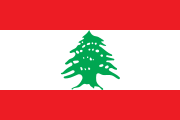
Back بوابة:لبنان Arabic بوابة:لبنان ARZ Portail:Liban French Portale:Libano Italian Portal:Lubnan Malay Portal:Líbano Portuguese Портал:Ливан Russian باب:لبنان Urdu Cổng thông tin:Liban Vietnamese
The Lebanon PortalA view of Byblos, Lebanon
 Lebanon (/ˈlɛbənɒn, -nən/ LEB-ə-non, -nən; Arabic: لُبْنَان, romanized: Lubnān, local pronunciation: [lɪbˈneːn]), officially the Republic of Lebanon, is a country in the Levant region of West Asia. It is bordered by Syria to the north and east, by Israel to the south, and by the Mediterranean Sea to the west; Cyprus lies a short distance away from the country's coastline. Lebanon is located at the crossroads of the Mediterranean Basin and the Arabian hinterlands. Lebanon has a population of more than five million people and covers an area of 10,452 square kilometres (4,036 sq mi). Beirut is the country's capital and largest city. The earliest evidence of human civilization in Lebanon dates back to 5000 BCE. From 3200 to 539 BC, what was to become Lebanon was part of Phoenicia, a maritime empire that stretched the Mediterranean Basin. In 64 BC, the region of Lebanon became part of the Roman Empire, which soon became a major center for Christianity under the aegis of the Byzantine Empire. After the 7th century, the region came under the rule of different caliphates, including the Rashidun, Umayyad and Abbasid caliphates. The 11th century saw the beginning of the Crusades and the establishment of Crusader states, which later fell to the Ayyubids and the Mamluks, and eventually to the Ottomans. Under Ottoman ruler Abdulmejid I, the first Lebanese proto-state was established in the form of the Mount Lebanon Mutasarrifate, created in the 19th century as a home for Maronite Christians under the Ottoman Tanzimat period. Lebanon is a developing country, ranked 112th on the Human Development Index. It has been classified as an upper-middle-income state. The Lebanese liquidity crisis, coupled with nationwide corruption and recent disasters such as the 2020 Beirut explosion, have precipitated the collapse of Lebanon's currency and fomented political instability, widespread resource shortages, and high unemployment and poverty. The World Bank has defined Lebanon's economic crisis as one of the world's worst since the 19th century. Despite the country's small size, Lebanese culture is renowned both in the Arab world and globally, powered primarily by the Lebanese diaspora. Lebanon is a founding member of the United Nations and of the Arab League, and is a member of the Non-Aligned Movement, the Organization of Islamic Cooperation, the Organisation internationale de la Francophonie, and the Group of 77, among others. (Full article...) This is a Featured article, one of the best articles Wikipedia has to offer.
 The Temple of Eshmun (Arabic: معبد أشمون) is an ancient place of worship dedicated to Eshmun, the Phoenician god of healing. It is located near the Awali river, 2 kilometres (1.2 mi) northeast of Sidon in southwestern Lebanon. The site was occupied from the 7th century BC to the 8th century AD, suggesting an integrated relationship with the nearby city of Sidon. Although originally constructed by Sidonian king Eshmunazar II in the Achaemenid era (c. 529–333 BC) to celebrate the city's recovered wealth and stature, the temple complex was greatly expanded by Bodashtart, Yatonmilk and later monarchs. Because the continued expansion spanned many centuries of alternating independence and foreign hegemony, the sanctuary features a wealth of different architectural and decorative styles and influences. The sanctuary consists of an esplanade and a grand court limited by a huge limestone terrace wall that supports a monumental podium which was once topped by Eshmun's Greco-Persian style marble temple. The sanctuary features a series of ritual ablution basins fed by canals channeling water from the Asclepius river (modern Awali) and from the sacred "YDLL" spring; these installations were used for therapeutic and purificatory purposes that characterize the cult of Eshmun. The sanctuary site has yielded many artifacts of value, especially those inscribed with Phoenician texts, such as the Bodashtart inscriptions and the Eshmun inscription, providing valuable insight into the site's history and that of ancient Sidon. The Eshmun Temple was improved during the early Roman Empire with a colonnade street, but declined after earthquakes and fell into oblivion as Christianity replaced polytheism and its large limestone blocks were used to build later structures. The temple site was rediscovered in 1900 by local treasure hunters who stirred the curiosity of international scholars. Maurice Dunand, a French archaeologist, thoroughly excavated the site from 1963 until the beginning of the Lebanese Civil War in 1975. After the end of the hostilities and the retreat of Israel from Southern Lebanon, the site was rehabilitated and inscribed to the World Heritage Site tentative list. (Full article...)Did you know (auto-generated) -
TopicsRelated portalsReligions in Lebanon Arab states Other countries This is a Good article, an article that meets a core set of editorial standards.
Lebanon sent a delegation to compete at the 1952 Winter Olympics in Oslo, Norway from 14 to 25 February 1952. This was the country's second time competing in a Winter Olympic Games, after their first appearance four years prior. Lebanon was represented in these Olympics by a single alpine skier, Ibrahim Geagea. He competed in three events, and his best finish was 57th in the men's downhill competition. (Full article...) General imagesThe following are images from various Lebanon-related articles on Wikipedia.
CategoriesAssociated WikimediaThe following Wikimedia Foundation sister projects provide more on this subject:
SourcesDiscover Wikipedia using portals |
© MMXXIII Rich X Search. We shall prevail. All rights reserved. Rich X Search






















































